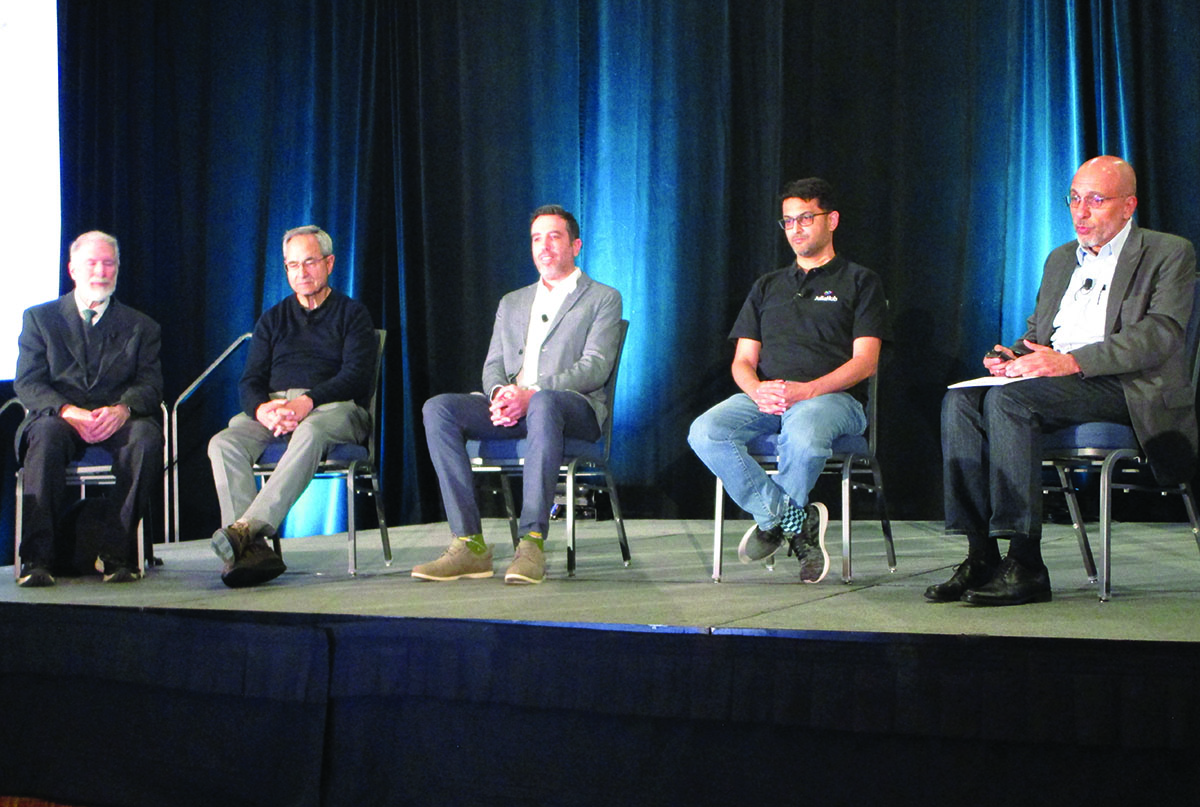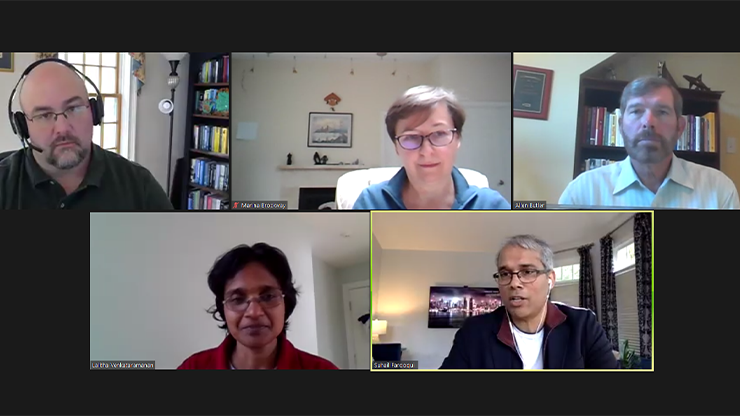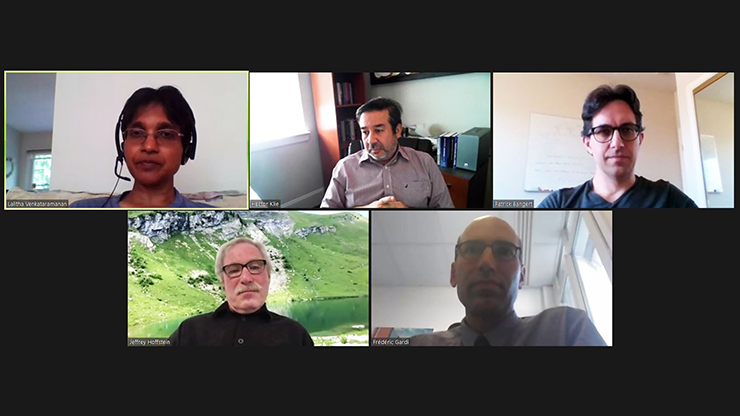CSE25 Panel Explores Entrepreneurship Prospects in Computational Science and Engineering
As junior researchers in applied mathematics, computational science, and data science prepare to enter the workforce, a variety of career possibilities await them. In addition to the more conventional paths in academia, industry, and government, the prospect of entrepreneurship offers unique opportunities for ambitious scientists with big ideas that may benefit the larger community. Innovations in hardware and software—coupled with ongoing advances in artificial intelligence (AI) and an increasing reliance on digital technologies—mean that the concept-to-value packaging of scientific tools can occur more rapidly than ever. This changing landscape has lowered the barrier to entry for the mathematical and computational product market, paving the way for new math-based technologies that target complex societal, economic, and industrial challenges.

During the 2025 SIAM Conference on Computational Science and Engineering, which took place last month in Fort Worth, Texas, a panel session explored the world of entrepreneurship in science, technology, engineering, and mathematics (STEM). Amr El-Bakry of ExxonMobil moderated an engaging discussion that featured Glenn Ricart of US Ignite and the University of Utah, Rob Schreiber of Cerebras Systems, Daniel Shabtai of Prism AI Therapeutics, and Viral Shah of JuliaHub. Throughout the session, panelists spoke about their own entrepreneurial endeavors and offered advice to attendees who might wish to start their own companies or package novel products.
El-Bakry opened the conversation by familiarizing attendees with the notion of entrepreneurship. Though many definitions exist for the enterprise, he feels that Wikipedia’s description accurately captures its risk-reward, value-based spirit: Entrepreneurship is the creation or extraction of economic value in ways that generally entail beyond the minimal amount of risk (assumed by a traditional business), and potentially involving values besides simply economic ones. “There is something new,” El-Bakry said. “There is a risk that needs to be taken, a big change that is the outcome of the particular activity, and a value for that outcome.”
El-Bakry pointed to the enormous wealth of untapped mathematical technology as inspiration for aspiring entrepreneurs. As new, useful products continue to enter the market, computational scientists and applied mathematicians are uniquely situated to build upon these products and develop other commodities that help with decision-making and problem-solving. This persistent evolutionary loop is changing the role of STEM researchers in industry and generating newfound opportunities. “Math is the money,” El-Bakry said. “You’re packaging a math formulation into an actual value. It’s an amazing progression.”
With substantial experience in academia, government, for-profit companies, and now a nonprofit startup, Ricart has witnessed this progression firsthand. He noted that despite changes to the research environment over the years, entrepreneurial success remains dependent on market value. “Markets are kind of the important thing,” he said, citing the necessity of both a clear need and a willing customer base. “You have to find an underserved market — someplace that needs what you can provide and isn’t already fully occupied.”
As co-founder and chief technology officer of US Ignite—a company that works with communities, startups, military bases, and researchers to solve problems in technological innovation and economic development—Ricart is acutely aware of both current and projected market trends. He identified energy, air quality, transportation, and education as distinct markets that will likely benefit from novel, patentable technologies in the coming years. Ricart also acknowledged a number of tools and research fields that industrial scientists can harness and improve upon. “Quantum networking is a very important and rapidly moving area right now,” he said. “And if you’re into AI, there are things underlying large language models called transformers.” Privacy is another key focus area, as users increasingly want their devices to retain a certain level of confidentiality regarding their data.
When would-be entrepreneurs prepare to pitch their concepts to the appropriate markets, effective idea sharing is perhaps the most influential driver of their efforts. “Get your ideas out into the marketplace,” Schreiber said. “That’s a terrific reason to get involved with new companies; old companies are very slow moving.” Schreiber is no stranger to startups, having engaged with four—TRW Array Processors, Saxpy Computer Corporation, MasPar Computer Corporation, and most recently Cerebras—throughout his career. He remarked that prospective investors are typically concerned with several specific types of risks: market, technical, management, and financial. Market risk is often the most significant, as venture capitalists generally want to ensure that a product is sustainable before providing significant funds.
Strong initial investments are critical, and Schreiber cautioned against using one’s own reserves to start a company. “Don’t fund this out of your own pocket,” he said. “If you can’t get funding from people who do that for a living, there might be a reason. Look to your business plan, not your 401(k).”
In fact, entrepreneurs frequently reassess their business proposals—especially in the early stages of development—and Shah observed that the journey from idea to product is rarely direct. “You have to solve the inverse problem,” he said. “The product out there that people will pay for is not the one that you imagined. This is where many startups die; it’s what makes entrepreneurship hard.” In some cases, several potential implementations might seem to fit the vision. “The inverse problem can have many solutions,” Shah continued, pointing to the multitude of questions that shape the decision-making process. Do you build a product or a platform? Will it sell itself? Do you need salespeople? Given the importance of such queries, entrepreneurs should solicit routine feedback from prospective investors and customers, then adjust their plans accordingly.

Another source of valuable input is a startup’s own employees. As such, hiring a balanced team facilitates stronger brainstorming sessions and enables effective task delegation — especially since the startup world is far too demanding for a single person on their own. “Entrepreneurship is not a solo game,” Shah said. “It’s a team sport. If you’re going to do this, you’ll need friends and partners who complement you in different ways.” These individuals’ skillsets should comprise a mix of technical and interpersonal proficiencies, marketing experience, and management expertise. “You don’t want ‘yes men’ who agree with everything you say,” Shah added. “You want people who will challenge you.”
Shah spoke highly of the managers, salespeople, and technical engineers who allowed him and his colleagues to develop the Julia programming language and ultimately found JuliaHub. He explained that while Julia began as an open-source ecosystem, the team eventually decided that the true value did not necessarily lie in Julia itself, but rather in the creation of modeling and simulation products with Julia. They thus chose to build a platform, and JuliaHub was born. The enterprise continues to grow—JuliaHub now includes multiple platforms as product offerings—and Shah and his collaborators are in the process of launching a simulation product called JuliaSim that targets engineers.
Shabtai also credited his talented associates for the success of Prism AI: an AI-first clinical multiomics data management and analytics platform that aims to expedite the development of next-generation drugs and biomarkers. Prism AI applies various AI technologies—including supervised learning, large language models, and foundation models—to address problems in disease and drug modeling, drug target identification, patient screening, surrogate markers, and mechanisms of action. “AI is a breakthrough in so many areas, and that’s also the case in the field of healthcare,” Shabtai said. “We’re reaching a place where we can do screening to detect disease. We’re able to understand disease models and figure out specific treatments for specific people.”
When co-founding Prism AI, Shabtai relied upon his decade-long background in a dynamic corporate environment. “I joined Meta when it was still Facebook,” he said of his previous experience. “I saw how it shifted from a small company to a company with tens of thousands of people.” This exposure to cutting-edge industry growth acquainted Shabtai with the particularities of the business world before he took the entrepreneurial plunge. He was particularly involved with Facebook’s video platform and became familiar with several video components—such as autoplay and scrolling—that are still in use today, ultimately building a competitive market product that was second only to YouTube.
Other panelists benefited from prior industry or consulting experience as well. For example, Schreiber previously contributed to software research projects at NASA, Hewlett-Packard, and MATLAB. While at Saxpy, he helped to build one of the first parallel machines that was capable of gigaflop performance; as a consultant for MasPar, he wrote linear algebra software. Since 2017, Schreiber has found satisfaction in his work as an engineer at Cerebras. “It’s a fantastic company,” he said. “We’re selling machines as fast as we can make them. It has a technical advantage and is doing something that the electrical engineers made possible: building machines with a chip that is not the size of a quarter, but the size of a plate.”
All of the speakers’ personal stories affirmed that entrepreneurship is a long-term commitment. “Any meaningful contribution to society is going to be a decade of your life, maybe longer,” Shah said, adding that entrepreneurs must maintain a healthy balance between optimism and pessimism throughout the development and launch process. A sense of resilience and flexibility is also key, since nearly everyone encounters setbacks at one point or another. “Take risks,” Shabtai said. “The best lessons throughout my career are when I failed miserably and said that I wasn’t going to let it happen again. Fail fast, know to say if something is not working, and shift to another direction.”
As the session drew to a close, the panelists reiterated the importance of a curious mindset, willingness to share ideas, proactive vision of future market need, and feeling of excitement at the unknown. And while imposter syndrome is common, Shabtai urged attendees to push through and remain confident in their abilities. “You can do it,” he said. “You never know unless you try.”
About the Author
Lina Sorg
Managing editor, SIAM News
Lina Sorg is the managing editor of SIAM News.

Stay Up-to-Date with Email Alerts
Sign up for our monthly newsletter and emails about other topics of your choosing.






